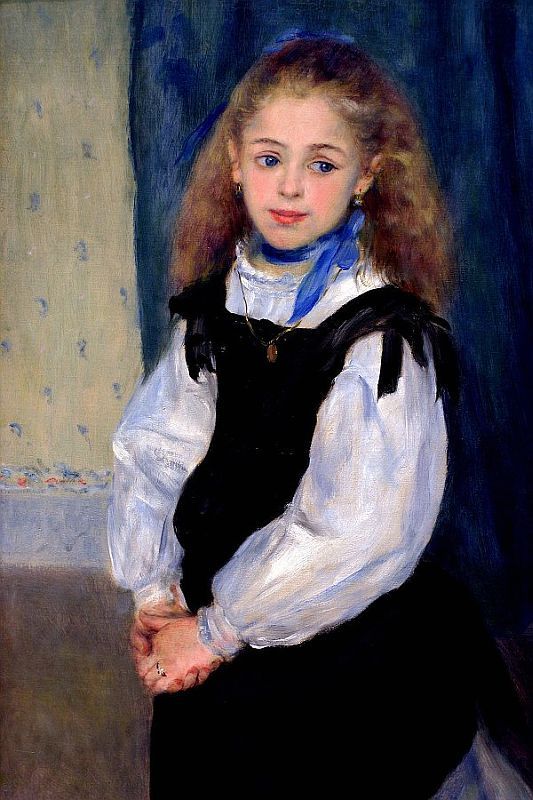Zach mentioned in our last class that second graders are more familiar with Da Vinci and Picasso than with any of the modern artists on the scene today. I think that it’s a good observation, but like most good observations, I’m not about to leave it at that. Zach suggested that the reason behind this “deficiency” (for lack of a better word) is that so many people are considered artists today that it’s almost impossible to determine who is worth telling kids about. I do agree with that explanation, but I’d like to offer an alternative one. Perhaps – and this could be entirely off the mark – it has something to do with censorship.

Renoir's "Mademoiselle Legrand, 1875" is an innocuous painting, both graphically and conceptually, that is most definitely suitable for a younger viewership
I make sweeping statements a lot in these posts of mine, and I guess this one will be no exception. Take this with a grain of salt, okay? So this is my gross generalization: Classic/older art = more subdued, less questionable content. Modern/post-modern art = brow-raising, sometimes downright shocking content. I know it’s not entirely true regarding every individual work (and it might not even be true as a generality), but I think that part of the reason kids don’t know about say, Tracey Emin, but do know about Da Vinci is because of a certain hesitance on behalf of parents and educators to expose children to certain, um, mature elements of art. Maybe not. You can just scratch this whole theory if you want. Now that I’ve worked it out in writing, I’m not sure I agree with it so much either.
But onto my next point – censorship need not imply filtering out potentially corrupting material. As in, determining age-appropriate content in general involves considering conceptually age-appropriate content as much as it does visually age-appropriate content. Ready for my next generalization? Classic/older art = more point-blank and concrete. Modern/post-modern art = more malleable and abstract. On a pedagogical level, it would be ridiculous to expose children to abstract art and expect them to appreciate it without first determining whether or not they are cognitively capable of comprehending it (my post about The Willing Suspension of Disbelief touches on this). That’s why, like most kinds of effective instruction, art education comes in progressional drips. First – Rembrandt/Da Vinci. Next – Monet/Renoir/Degas. Then – Dali/Picasso. A while after that – bring on the big guns. What I mean to say is that there has to build-up to the cerebral crescendo that is conceptual art. It takes time, and it is probably most effectively conveyed to those who have passed adolescence and tweenhood. That’s why third graders don’t go around displaying their knowledge about De Kooning and Duchamp (not that many adults go around doing that either). I think this aspect of “censorship” might play a big part in Zach’s observation. It’s not censorship in the negative sense of the word. It’s merely in the pragmatic sense of the word. It opens up a whole new discussion about the nuances of art education – when to begin, how to begin, what to include, what to leave out, etc. Thankfully, that is not what my post is about, as those are all questions that I don’t think a day’s,week’s, month’s, or year’s worth of deliberation can effectively answer.


This is an interesting point. I agree with what you said about how “Classic/older art = more subdued, less questionable content. Modern/post-modern art = brow-raising, sometimes downright shocking content.” and “Classic/older art = more point-blank and concrete. Modern/post-modern art = more malleable and abstract.” Without a doubt it is easy to discern who Frans Halls was painting, while it is quite difficult to make out DeKooning’s Woman I. Also, Woman I is an abstract nude, while Halls painted people for family portraits. The human body is being exposed much more in art than has in past generations. Nowadays, it is less taboo to paint a nude figure, than it has been in the past. Parents and educators may not want their children seeing all of this artistic expressions.
I think that children learn about the masters for a few more reasons than are mentioned here. I think that it is not possible to learn about Duchamp, and DeKooning, without first learning about Davinci. It is difficult to explain the term abstract without for learning what an image looks like that is not abstract. Unlike what you said in the blog post, it is not that the children can not appreciate the art conceptually, it is that they will not know what it means. Also another reason why Children are exposed to Rembrandt before Pollack is because people like Rembrandt are famous, and have been famous over time. In kindergarten, it is important to teach kids about the general principles of art or of any subject. Rembrandt has stood the test of time and is famous. A new modern artist will not necessarily be famous in the next few years, and so it is not imperative that the child remembers the artist’s name. It is an interesting post, that I think has alot of merit.